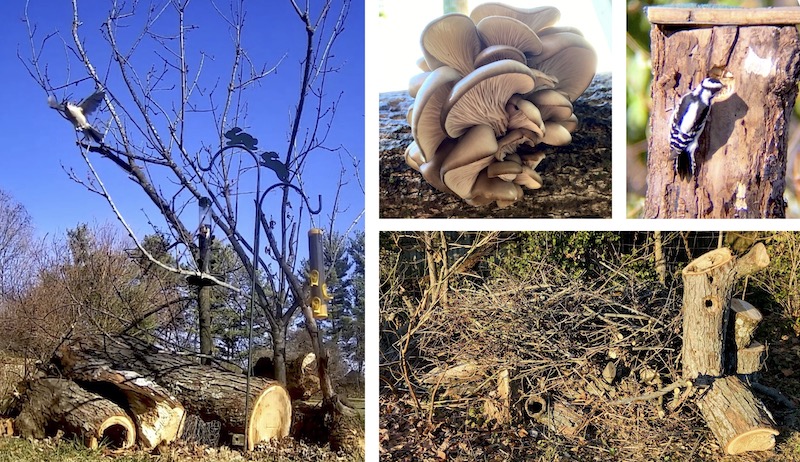
I knew the silver maple tree in my backyard was in pretty rotten shape, but hearing the decades-old tree fall was still a shock. (As it happens, one of my nature cams captured the whole sad spectacle on video.) A combination of water-logged soil and stiff, straight-line winds finally resulted in a fallen tree.
When I told friends what happened, they immediately jumped to the same conclusion: that I would be cutting the tree up for firewood. But I don’t have a fireplace or a wood-burning stove. And now I have even less habitat for the creatures that used to depend on that old tree for shelter.
As a result, I’ve been doing everything but stacking new firewood. What follows are 10 ways I’ve been using my old tree to help feed myself and support area wildlife, too.
And who knows? Maybe the next time you’re faced with a newly fallen tree, you’ll give some of these a try.
Bird Rest Stops
I used to love sitting near the old maple and watching the birds take shelter within its hollows and along its branches. Determined to restore some of what’s been lost, I’ve created a few bird rest stops.
First, I selected some large, sturdy limbs which still had several branches attached. Then I gathered several intact and hollow log sections. To keep grass and weeds from encroaching, I removed a small section of turf and covered the area with a thick layer of cardboard and fallen leaves.
Next, I arranged the logs so that they could sandwich and support some of the tree limbs. I positioned these limbs so they would stretch upward—like younger, smaller trees might. To keep the logs and limbs in place, I filled nooks and crannies with loose soil, watered it in well, and packed the soil down.
I planted sedum atop areas with exposed soil and sowed some perennials around the logs as well.
Finally, I added a bird feeder pole, along with black oil sunflower seed and thistle seed feeders. My mini rest stops have been well-trafficked ever since.
Forts & Blinds
If you collect enough similarly-sized sticks, you (or the kids!) can use them to create a lovely natural fort or even a photography blind. Once inside your hiding spot, you can more easily snap close-ups of birds and other animals.
Got Burls?
Stressed-out trees are much more likely to produce burls—rare growths prized by some woodworkers. If you have them, you may be able to sell your tree’s burls for top dollar. Or you can make something beautiful from them yourself.
Suet Log Feeders
I drilled a series of staggered holes in some of my longer, wider logs and then filled the holes with softened suet. Whether you hang or stack these suet-filled logs, woodpeckers, Northern flickers and other birds will flock to them.
Mushroom Magic
Depending on what kind of fallen tree you have, you just might be able to inoculate some thicker limb sections with mushroom spawn plugs. You can also inoculate large (green/live) logs using the totem method.

When selecting logs to inoculate, be sure to get them up off the ground as soon as possible. Store them on a clean tarp or large piece of cardboard to prevent other fungi from moving in before you have a chance to introduce your fungus of choice.
Although mushroom logs take some work and maintenance up front, they’ll pay dividends for many years.
Large Wildlife Habitat
My tree already had some large dead sections. So, once it fell, I was left with a number of hollow or partially hollow logs.
I arranged some of these to create shelter for larger animals like rabbits, possums and raccoons. To begin, I cleared away turf and weeds, laid down cardboard and topped with fallen leaves. Next, I added a large pallet and surrounded this with logs—some standing on end and others on their sides.
Finally, I filled in the remaining space with large limbs and smaller twigs and sticks. Eventually, critters will rearrange this habitat as needed. (See photo.)
Hügelkultur
You can use up many of your leftover logs by stacking them inside a trench or at ground level to create a hügelkultur planting bed.
Read more: Learn about the traditional, European permaculture technique of hügelkultur.
Woodpecker Houses
If you have at least one hollow log section that’s just over a foot long, you might have what you need to make a nice downy woodpecker house. (See photo and details here.)
Compost or Mulch
Whether you own, borrow or rent a chipper/shredder, you can use it to make fast work of smaller limbs and branches. Then, use the chipped wood from your fallen tree to mulch landscaping plants or periodically add it to compost piles in need of carbon-rich material.
Mill It
New lumber isn’t cheap, and your fallen tree could supply you with enough boards for your next few projects. Seek out someone near you with a portable sawmill and you’re in business.




